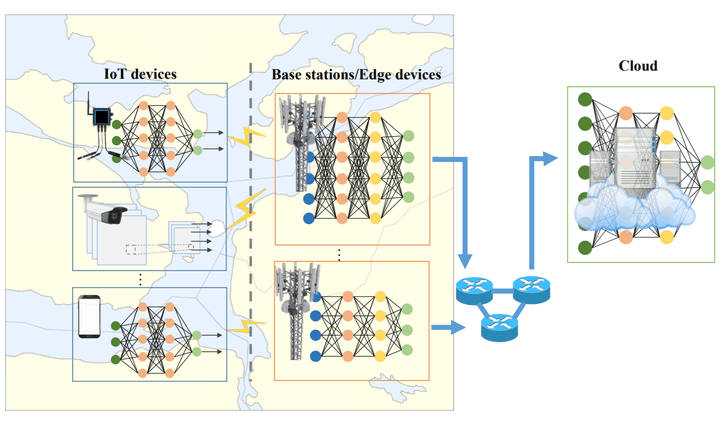Kursens fokus är på maskininlärningsmetoder och -algoritmer som kör överkommunikationsprotokoll för sakernas internet (IoT). Kursen startar med en introduktion av tillämpningar av nätverksarkitektur. Därefter behandlas metoder för kommunikationsprotokoll och hur dess metoder kan tillämpas för design av viktiga aspekter i kommunikationsprotokollstacken. Kursen analyserar maskininlärningsalgoritmer som kan köras på IoT-system där data och beräkningar är distribuerade.
EP271V Sakernas internet och artificiell intelligens 7,5 hp
Denna kurs är under avveckling.
Avvecklingsbeslut:
Kursen avvecklas vid utgången av HT 2027 enligt fakultetsnämndsbeslut: HS-2025-2307.
Beslutsdatum: 2025-10-07
Kursen ges sista gången HT 2025. Sista möjlighet till examination i kursen ges HT 2027.
Kontakta examinator för att bli examinerad under avvecklingsperioden.

Sakernas internet (IoT) och artificiell intelligens (AI) är tekniker som möjliggör ”en värld där allt är uppkopplat” eftersom de kan ansluta till fysiska föremål, personer, infrastruktur och företag. IoT och AI tillåter oss att samla in data, göra dataanalys och i slutändan fatta optimala beslut. Vi kommer att använda IoT och AI i den digitaliserade världen, där fordon kommer att köra utan mänskliga förare och energi- och vattenresurser kommer att distribueras mycket mer effektivt än i dag. Denna kurs ger en översikt över några av de viktigaste kommunikationsaspekterna för trådlös IoT, samt AI för dessa IoT-aspekter.
Information per kursomgång
Information för HT 2025 Start 2025-08-25 fristående studerande
- Studielokalisering
KTH Campus
- Varaktighet
- 2025-08-25 - 2025-10-24
- Perioder
HT 2025: P1 (7.5 hp)
- Studietakt
50%
- Anmälningskod
10062
- Undervisningsform
Normal Dagtid
- Undervisningsspråk
Engelska
- Kurs-PM
- Kurs-PM är inte publicerat
- Antal platser
5 - 25
- Målgrupp
- Fristående studerande
- Planerade schemamoduler
- [object Object]
- Schema
- Del av program
- Ingen information tillagd
Kontakt
Kursplan som PDF
Notera: all information från kursplanen visas i tillgängligt format på denna sida.
Kursplan EP271V (HT 2025–)Innehåll och lärandemål
Kursinnehåll
Lärandemål
Efter godkänd kurs ska studenten kunna:
- redogöra för de centrala verktygen för kommunikationsteknik för sakernas internet (IoT)
- designa IoT-system
- redogöra för centrala maskininlärningsmetoder för sakernas internet
- designa maskininlärningsmetoder för IoT-system
i syfte att:
- förstå och förklara vilka designmöjligheter som finns för ett specifikt kommunikationssystem
- kunna argumentera för vilken typ av prestanda som ska prioriteras i designen av IoTsystem och maskininlärningsmetoder
- förstå och förklara vilka designmöjligheter för maskininlärningsalgoritmer som finns för att köra dessa algoritmer över ett specifikt kommunikationssystem.
Kurslitteratur och förberedelser
Särskild behörighet
- Totalt 180 hp varav minst 90 hp inom elektroteknik, teknisk fysik eller teknisk
- matematik.
- Kunskaper i envariabelanalys, 6 hp.
- Kunskaper i datorkommunikation, 6 hp.
- Kunskaper i sannolikhetsteori, 6 hp.
- Gymnasiekursen Engelska B/6.
Kurslitteratur
Examination och slutförande
Betygsskala
Examination
- PRO1 - Projektarbete, 1,5 hp, betygsskala: A, B, C, D, E, FX, F
- LAB1 - Laborationsuppgift, 2,0 hp, betygsskala: A, B, C, D, E, FX, F
- LAB2 - Laborationsuppgift, 2,0 hp, betygsskala: A, B, C, D, E, FX, F
- LAB3 - Laborationsuppgift, 2,0 hp, betygsskala: A, B, C, D, E, FX, F
Examinator beslutar, baserat på rekommendation från KTH:s handläggare av stöd till studenter med funktionsnedsättning, om eventuell anpassad examination för studenter med dokumenterad, varaktig funktionsnedsättning.
Examinator får medge annan examinationsform vid omexamination av enstaka studenter.
När kurs inte längre ges har student möjlighet att examineras under ytterligare två läsår.
Examinator
Etiskt förhållningssätt
- Vid grupparbete har alla i gruppen ansvar för gruppens arbete.
- Vid examination ska varje student ärligt redovisa hjälp som erhållits och källor som använts.
- Vid muntlig examination ska varje student kunna redogöra för hela uppgiften och hela lösningen.